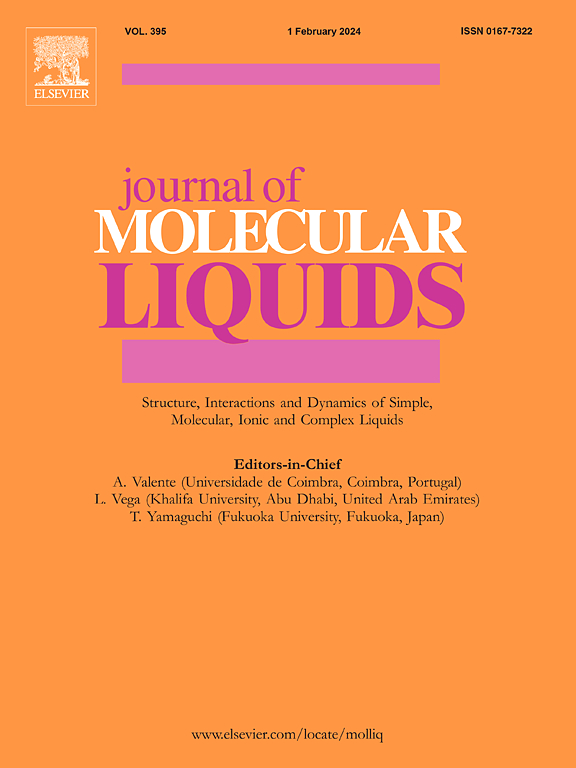A novel electro-spun Cu-MOF loaded PAN/cellulose membrane for efficient adsorption-assisted photocatalytic decontamination of bisphenol A: Kinetics, thermodynamics, and mechanistic study
IF 5.3
2区 化学
Q2 CHEMISTRY, PHYSICAL
引用次数: 0
Abstract
Electrospun membranes have gained attention for wastewater treatment, but pristine nanofiber membranes like Polyacrylonitrile (PAN) often have limited adsorption and photocatalytic efficiency. A hybrid membrane was developed to address this, combining PAN, cellulose, and a metal–organic framework (MOF) to create a multifunctional photocatalytic adsorbent. The membrane was fabricated using an electrospinning process. PAN was infused with copper-based MOF (Cu-MOF), and cellulose was blended with polyethylene oxide (PEO), resulting in an integrated membrane structure. Structural characterization confirmed the uniform distribution and firm adhesion of Cu-MOF to the PAN fibers. The photocatalytic potential of the synthesized membrane was evaluated for the removal of bisphenol A (BPA) from water under visible light irradiation. The PAN/Cellulose nanofiber substrate loaded with 1.0 g of Cu-MOF (PAN/Cell/MOF-III) achieved 98 % removal efficiency. The PAN, PAN/Cell, pristine Cu-MOF, PAN/Cell/MOF-I, PAN/Cell/MOF-II, and PAN/Cell/MOF-III exhibited adsorption capacities of 4.0, 19.9, 69.1, 30.7, 47.4, and 87 mg/g, respectively. The effects of key factors, including membrane dosage, solution pH, and BPA concentration, on the adsorption and degradation efficiency of PAN/Cell/MOF-III were systematically explored. Trapping species and Electron Paramagnetic Resonance (EPR), studies identified holes (h+) and superoxide radicals (O2![]() −) as the primary reactive species responsible for BPA degradation. Kinetic analysis revealed degradation followed a pseudo-first-order model, while adsorption followed a pseudo-second-order model. Thermodynamic parameters (ΔGads, ΔHads, ΔSads) indicated spontaneous, physical, and endothermic adsorption. The Langmuir and Dubinin-Radushkevich isotherm models accurately fit the adsorption data. The PAN/Cell/MOF-III membrane showed excellent reusability over five cycles, demonstrating its potential for practical wastewater treatment applications.
−) as the primary reactive species responsible for BPA degradation. Kinetic analysis revealed degradation followed a pseudo-first-order model, while adsorption followed a pseudo-second-order model. Thermodynamic parameters (ΔGads, ΔHads, ΔSads) indicated spontaneous, physical, and endothermic adsorption. The Langmuir and Dubinin-Radushkevich isotherm models accurately fit the adsorption data. The PAN/Cell/MOF-III membrane showed excellent reusability over five cycles, demonstrating its potential for practical wastewater treatment applications.
求助全文
约1分钟内获得全文
求助全文
来源期刊

Journal of Molecular Liquids
化学-物理:原子、分子和化学物理
CiteScore
10.30
自引率
16.70%
发文量
2597
审稿时长
78 days
期刊介绍:
The journal includes papers in the following areas:
– Simple organic liquids and mixtures
– Ionic liquids
– Surfactant solutions (including micelles and vesicles) and liquid interfaces
– Colloidal solutions and nanoparticles
– Thermotropic and lyotropic liquid crystals
– Ferrofluids
– Water, aqueous solutions and other hydrogen-bonded liquids
– Lubricants, polymer solutions and melts
– Molten metals and salts
– Phase transitions and critical phenomena in liquids and confined fluids
– Self assembly in complex liquids.– Biomolecules in solution
The emphasis is on the molecular (or microscopic) understanding of particular liquids or liquid systems, especially concerning structure, dynamics and intermolecular forces. The experimental techniques used may include:
– Conventional spectroscopy (mid-IR and far-IR, Raman, NMR, etc.)
– Non-linear optics and time resolved spectroscopy (psec, fsec, asec, ISRS, etc.)
– Light scattering (Rayleigh, Brillouin, PCS, etc.)
– Dielectric relaxation
– X-ray and neutron scattering and diffraction.
Experimental studies, computer simulations (MD or MC) and analytical theory will be considered for publication; papers just reporting experimental results that do not contribute to the understanding of the fundamentals of molecular and ionic liquids will not be accepted. Only papers of a non-routine nature and advancing the field will be considered for publication.
 求助内容:
求助内容: 应助结果提醒方式:
应助结果提醒方式:


